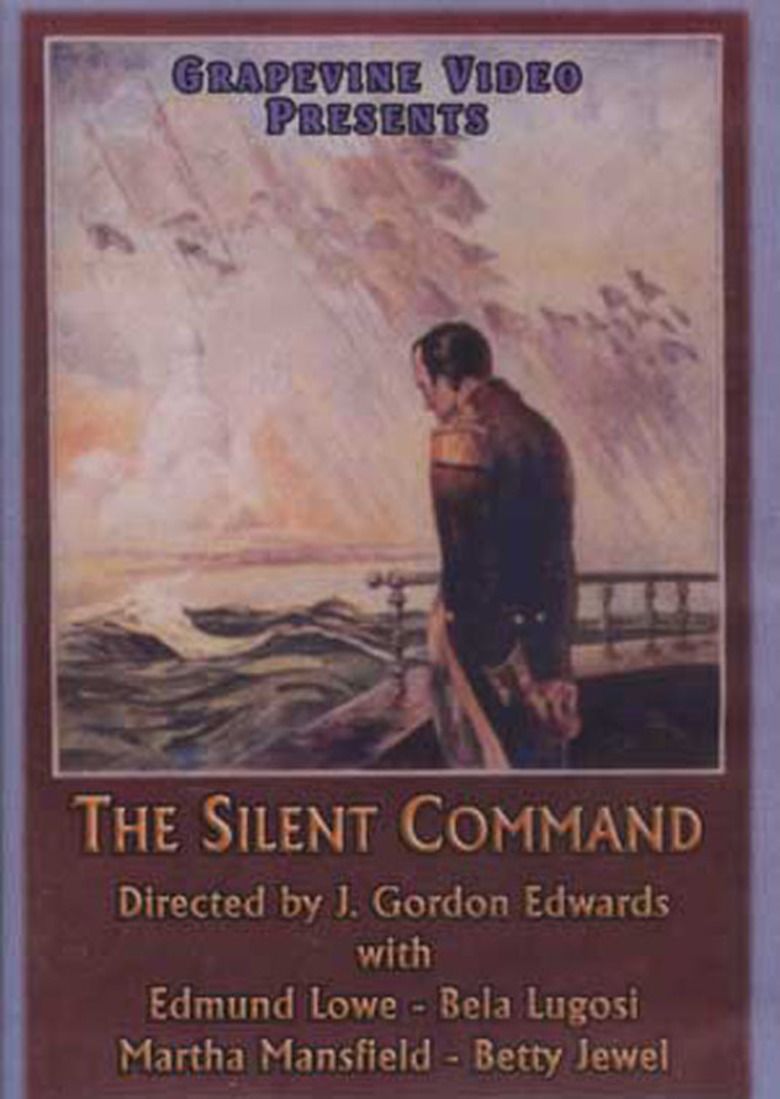The Silent Command
6.2 /10 1 Votes6.2
Director J. Gordon Edwards Country United States | 6/10 IMDb Genre Drama Duration | |||||||||||||||||||||||||||||||||
 | ||||||||||||||||||||||||||||||||||
Release date August 19, 1923 (1923-08-19) Genres Silent film, Drama, Indie film, Black-and-white Cast (Capt. Decatur), (Mrs. Richard Decatur), (Peg Williams), (Hisston), Betty Jewel (Dolores), (Menchen)Similar movies Bela Lugosi appears in The Silent Command and The Midnight Girl | ||||||||||||||||||||||||||||||||||
The silent command 1923
The Silent Command is a 1923 American silent drama film directed by J. Gordon Edwards and features Bela Lugosi as a foreign saboteur in his American film debut. The film, written by Anthony Paul Kelly and Rufus King, also stars Edmund Lowe. The film depicts the story of Benedict Hisston (Lugosi), who is part of a plot to destroy the Panama Canal. Initially unable to obtain necessarily intelligence from Richard Decatur (Lowe), a captain in the United States Navy, he enlists the aid of femme fatale Peg Williams (Martha Mansfield). Decatur pretends to be seduced into the conspiracy, costing him his career and marriage, but ultimately betrays the saboteurs in Panama and stops their plan. He returns home to the Navy and his wife, and to popular acclaim for his heroics.
Contents
- The silent command 1923
- The silent command holdercut avi
- Plot
- Cast
- Production
- Release and reception
- Legacy
- References
The film was produced in cooperation with the Navy and was intended as a propaganda film to encourage support for a larger navy. It began Lugosi's career in the American movie industry. Unlike most Fox Film productions of the silent era, several copies of The Silent Command have survived, and it is available in on home video.
The silent command holdercut avi
Plot
Benadict Hisston is a foreign agent, part of a conspiracy to destroy the Panama Canal and the United States Navy's Atlantic Fleet. He attempts to acquire information about mine placement in the Canal Zone from Captain Richard Decatur, but fails. With that information essential to the conspiracy's success, he then hires vamp Peg Williams to obtain the intelligence through seduction.
Decatur is not fooled, and obeys the "silent command" of the Chief of Naval Intelligence to play along with the spies without revealing his purpose to friends or family. He is court-martialed, stripped of rank, and dismissed from the Navy after he strikes an admiral. His association with Williams estranges him from his wife, but earns him the trust of Hisston and the other spies. When the conspirators are ready to enact their plan, he travels to Panama with them. He thwarts their attempt at sabotage, saving the canal and the fleet. He is reinstated into the Navy, reunited with his wife, and honored by the nation for his heroism.
Cast
Production
The Silent Command was not based on previous published material. Rufus King, later known for his detective novels, wrote the original story, which was adapted into a screenplay by Anthony Paul Kelly. It was essentially intended as a propaganda film to encourage popular support for expansion of the United States Navy, and was made with the Navy's cooperation and support. Fox Film's publicity promoter, Wells Hawks, may have been responsible for this arrangement, as he had previously worked in a publicity role for the Navy Quotes praising the film, for use in advertising, were provided by several prominent members of the military, including General John J. Pershing and Theodore Roosevelt, Jr., the Assistant Secretary of the Navy. Years later, in a publicity interview for The Return of Chandu, Bela Lugosi commented on the irony of being a propagandist for naval expansion, when his native country, landlocked Hungary, "has no navy nor needs any!"
In December 1922, Lugosi had starred in a Greenwich Village play, The Red Poppy. The play performed poorly, but Lugosi, in the role of a thuggish Spaniard, received critical praise. He was cast as Hisston in The Silent Command based on the strength of that performance. Extreme close-ups of Lugosi's eyes were used throughout the film to reinforce perception of this character as evil. These shots may have been intended as allusions to the evil eye or hypnosis; Lugosi himself had previously played an evil hypnotist, modeled after Svengali, in the 1919 German film Sklaven fremdes Willens.
The Silent Command was initially released as an eight-reel film with a 91-minute run time. Subsequent releases cut 18 minutes and reduced it to seven reels. H.T. Hodge claimed to have shown a nine-reel version at the Palace Theatre in Abilene, Texas. The film was retitled His Country for distribution in France.
Release and reception
William Fox opened the first Pacific Coast movie theater in his Fox Theatres chain in Oakland, California on August 25, 1923. The first feature-length film shown at the Fox Oakland, as part of its grand opening gala, was The Silent Command, over a week before its New York premiere.
Many critics considered the focus on Lugosi's eyes to be cliché or even unintentionally humorous, but some moviegoers did find the shots genuinely frightening.
Legacy
The Silent Command was Lugosi's first American film, and influenced the direction of his career in cinema. Lugosi had expressed an interest in playing Latin lover characters in the model of Rudolph Valentino, but his performance as Hisston revealed him to be convincing in more villainous roles. The technique of focusing on his eyes in extreme close-up would also be revisited in many of his later horror films, and even used in advertising.
Unlike most of Edwards's films, copies of The Silent Command are preserved in three archives: the George Eastman Museum, the Department of Film at the Museum of Modern Art, and Brussels's Cinematek. Grapevine Video made the film available on VHS in 1999, and released a DVD edition in 2005.
References
The Silent Command WikipediaThe Silent Command IMDb The Silent Command themoviedb.org
